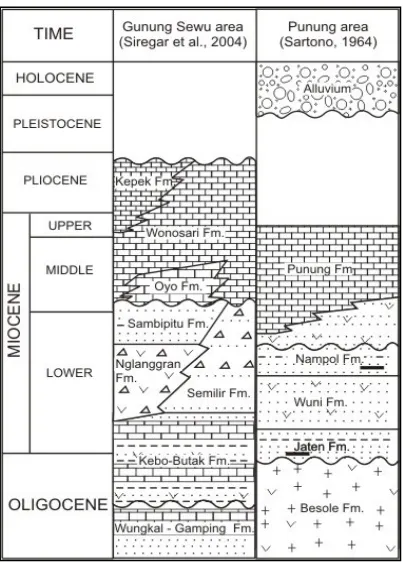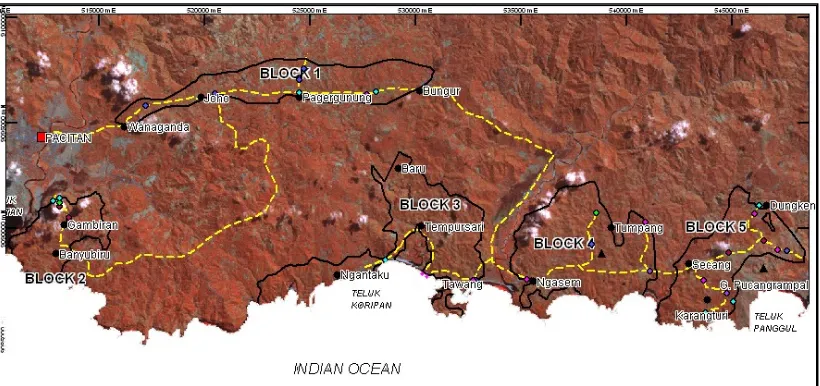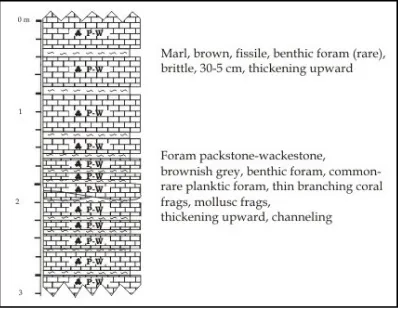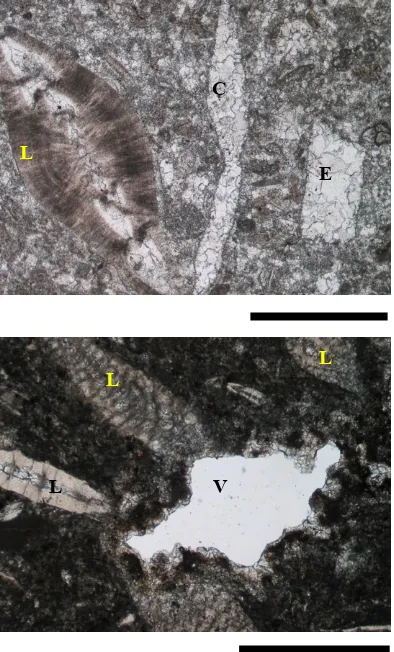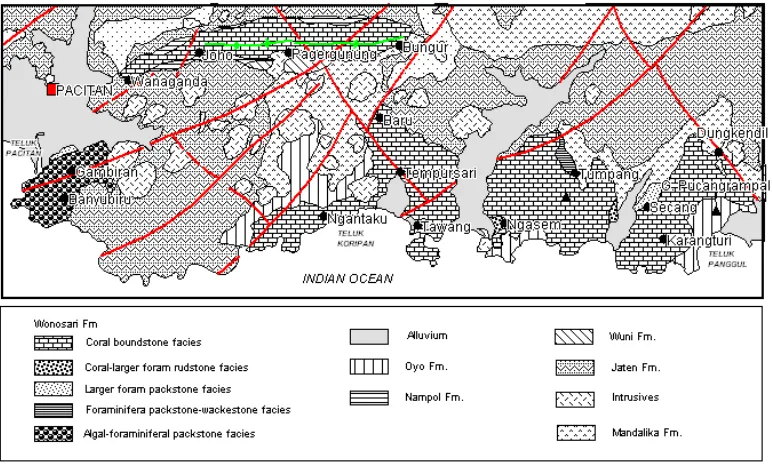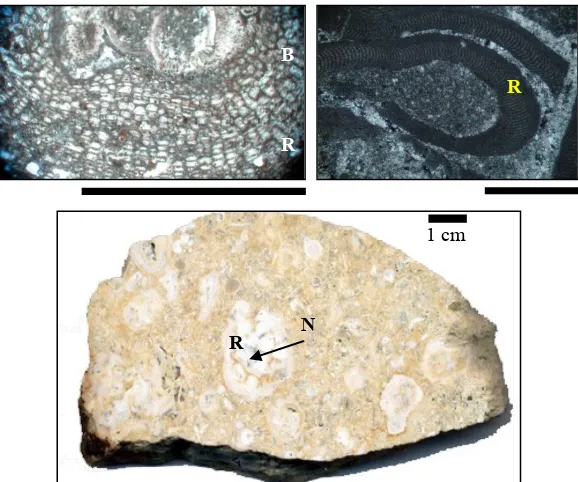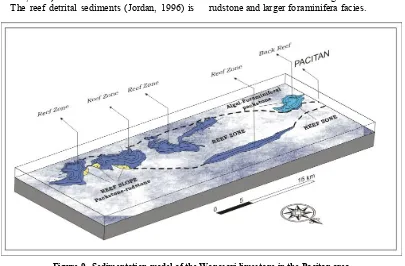CARBONATE DEPOSITIONAL ENVIRONMENT AND PLATFORM MORPHOLOGY OF THE WONOSARI FORMATION
IN THE AREA EAST OF PACITAN
M. Ma’ruf Mukti*, M. Safei Siregar*, Praptisih*, and N. Supriatna*
M. Ma’ruf Mukti, M. Safei Siregar, Praptisih, and N. Supriatna, Carbonate Depositional Environment and Platform Morphology of the Wonosari Formation in the Area East of Pacitan, RISET – Geologi dan Pertambangan Jilid 15 No.2 Tahun 2005, pp. 29 - 38, 9 figures, 1 table.
Abstract: Field observation and laboratory work have been conducted to determine the carbonate facies distribution and to interpret the environment of deposition and platform morphology of the Tertiary limestones of the Wonosari Formation in the east of Pacitan. All samples were then classified based on Jordan classification (1985), and being interpreted their environment of deposition. The Wonosari Formation in the east of Pacitan comprises of coral boundstone facies, foraminifera packstone-wackestone, larger foram packstone, coral-larger foram rudstone, and algal-foraminiferal packstone facies. These facies represent depositional environments of the reef zone or the outer shelf, basin-outer slope and middle-upper slope environments situated to the north of the reef zone, and a back reef-inner shelf environment to the south and west.
Sari: Penelitian lapangan dan analisa di laboratorium telah dilakukan untuk menentukan sebaran fasies karbonat dan interpretasi lingkungan pengendapan serta morfologi platform
dari batugamping Tersier Formasi Wonosari di sebelah timur Pacitan. Sampel batuan diklasifikasikan berdasarkan klasifikasi Jordan (1985) yang kemudian diinterpretasikan lingkungan pengedapannya. Formasi Wonosari di timur Pacitan terdiri atas fasies coral boundstone, foraminifera packstone-wackestone, larger foram packstone, coral-larger foram rudstone, dan fasies algal-foraminiferal packstone. Fasies-fasies tersebut mewakili lingkungan-lingkungan pengendapan reef zone atau outer-shelf, lingkungan basin-outer slope dan middle-upper slope yang terletak di utara reef zone, serta lingkungan back reef-inner shelf di sebelah selatan dan barat reef zone.
INTRODUCTION
Carbonate rocks are considered one of the main reservoir rocks in hydrocarbon exploration, especially for the Tertiary in Indonesia. Hence, the study of these rocks are very important for the petroleum geoscience. The hydrogeological aspects of the western area of Gunung Sewu of the Wonosari Formation, which comprises various facies types of carbonates have been studied by Utomo et al (1992), and Siregar et al (1994a and 1994b), in relation to hydrogeology study, and only covers the western area of
Gunung Sewu, while Sartono (1964) has studied this formation in the eastern area. The identification of the various facies types were mainly based on the Dunham (1962) classification. Regional geology investigations of this area have been conducted by Rahardjo et al (1995), and Sudarno (1997).
The main object of this study, the Wonosari Formation, based on previous facies determination, has been interpreted to represent a carbonate platform. This study extends the area of investigation to the eastern part basically
_______________________ *Pusat Penelitian Geoteknologi - LIPI
_______________________
30 employing the same carbonate facies classification of the environment of deposition and platform morphology.
The result of this study will provide us with a better overall picture of the Tertiary carbonate rocks and the tectonic setting of this region, which represent very important parameters in hydrocarbon exploration.
The research area is situated in the Pacitan area in East Java, located to the east of the Gunung Sewu area of Yogyakarta and Central Java. The Gunung Sewu geologic unit represents a rimmed shelf carbonate platform extending relatively in an east-west direction (Siregar et al,
2004). To the north of Gunung Sewu was a relatively deep (~200-400 m) fore arc basin, with volcaniclastic sedimentation derived from the volcanic arc to the north (Lokier, 1999). In the Pacitan area to the east, the Wonosari Formation developed in a different facies (Siregar et al, 2004) called as Punung Formation (Sartono, 1964). A correlation between the stratigraphy of the Gunung Sewu area (south of Yogyakarta & Central Java) and the Punung area (East Java) is shown in the Table 1 below. The present study of the Wonosari carbonate sedimentation to the east of Pacitan covers an area of about 110 km2.
Table 1. Stratigraphic Correlation of the Gunung Sewu and Punung Areas.
METHODOLOGY
The Jordan carbonate classification (1985, abbr. JCF) will be used in this study. The facies analyses in which the most significant elements of a carbonate rock are represented is shown in
the following equation:
Kepek Fm. : Intercalation of limestone and marl
Wonosari Fm. : Bedded limestone, coralline limestone, marly limestone, tuffaceous sandstone, marl
Oyo Fm. : Tuffaceous limestone, tuff, tuffaceous marl
Punung Fm. : Bedded limestone, reef limestone with bioherms and reef structures in limestone, marly limestone, interfingering with tuffaceous sandstone, clays, conglomeratic limestone, marl
Sambipitu Fm. : Intercalation of sandstone with carbonaceous shale
Nglanggran Fm. : Volcanic breccia, tuff, agglomerate, pillow lava, autoclastic breccia, epiclastic breccia
Semilir Fm. : Pumice breccia, tuff, tuffaceous sandstone, shale
Nampol Fm. : Agglomeratic sandstone, sandstone, sandy clays, conglomerate, lignite
Wuni Fm. : Coarse andesitic agglomerate, intercalation with tuffaceous sandstone, and sandstone, alternation of coral-reef limestone on the top
Kebo-Butak Fm. : Bedded limestone, marl, shale, agglomerate tuff, andesitic breccia, andesite lava
Jaten Fm. : Quartz sandstone, coarse sandstone, agglomeratic sandstone, sandy clays, clay, silicified wood, lignite
Besole Fm. : Dacite, tonalite, dacitic tuff, andesites
Wungkal-Gamping Fm. : Limestone, sandstone, sandy marl, clay
Carbonate Facies (CF) =
Composition and texture are the dominant factors in the equation. Composition is used for describing the sand-size (or larger) fraction of the rock or sediment. The most abundant grain type is listed first and is followed by the next most abundant one. Textural terms from Dunham (1969) considered the relative abundance of allochems and micrite but do not consider the identity of the different carbonate grains. Rocks are assigned names according to their depositional textures, which are related to the energy of the depositional environment. The JCF also takes into account the presence of gravel-size carbonate grains and the variation of boundstones according to the Dunham classification (as modified by Embry & Klovan 1971, in Tucker, 1990). Lithic descriptor and remarks are optional. Lithic descriptors are portrayed for sedimentary structures, admixtures of argillaceous or arenaceous material, diagenetic features and fractures. Remarks refer to minor features that are not logged as part of rock-forming particle types or textures. Remarks can be used to identify rare, special occurrences of fossils, sedimentary structures, porosity, or hydrocarbon shows.
The next step is to interpret the environment of deposition of these facies. The interpretation is
based on the Wilson carbonate depositional model (1975), which is constrained by the main biota composition, texture, sedimentary structures, and its associated sediments. The classification recognizes 24 types of microfacies assignable to nine standard facies belts, with the possibility of some microfacies types occuring in more than one facies belt (after Wilson, 1975; Flugel, 1982, in Jordan, 1995).
Each type of platform morphology has very distinctive characteristics. The term carbonate platform has been used in a very general and loose sense for a thick sequence of mostly shallow water carbonates (Tucker, 1990). Carbonate platforms develop in a whole range of geotectonic settings, but particularly along the passive continental margin, intracratonic basin to failed rifts, and back arc basins to foreland basins. Three main types of carbonate platform have been recognized: rimmed shelf, ramp, and isolated platform. Besides its geotectonic setting, platform morphology also depends on the facies variation and distribution, vertical facies changes, and the platform geometry. Correlation between several cross sections in a north-south direction in the studied area describes the relationship between the carbonate facies of the Wonosari Formation and the underlying formations.
32 All samples were taken during fieldwork in 2005, in which 64 outcrop sites were observed and sections measured. Site locations were predetermined based on previous facies maps, and geomorphology interpretation of Landsat imagery (Figure 1). 10 detailed measured section of interesting facies variations and lithology contacts were made, and samples collected with a minimum of 1 sample for each facies. From each sample a polished slab was prepared for megascopic determination, and a thin section for microscopic determination. From the 64 locations, 40 locations were selected for megascopic and microscopic analyses; these samples covered the interesting as well as the hitherto unrecognized facies in the field. A total of 40 thin sections and 10 polished slabs have been prepared.
RESULTS
Carbonate facies types
The location where observations were made in the research area (Figure 1), is extended from Pacitan in the west to Teluk Panggul in the east. The research area has been divided into 6 blocks based on the locality of the outcrops (Figure 1); they are Block 1 in the northeast of Pacitan, extending from Wanaganda in the west to Bungur in the east. Block 2 is located to the west of Pacitan, the third is in Pacitan to the east, the fourth is on the west side of Kali Lorog, Sudimoro, and the area adjacent next to the river in the east is Block 5. The most eastern block is located to the west of Teluk Panggul. Samples have been collected from 40 locations, and based on the facies determination they were classified into the following facies types:
Foraminifera packstone – wackestone facies
The texture of the packtone-wackestone (P/W) facies ranges from packstone to wackestone, with packstone being dominant. The rock constituents comprise mainly benthic foraminifera while planktonic foraminifera are common (Figure 2), the sediments being typically bedded, bed thickness of about 20-50
cm, grey to brownish grey in color, hard, and showing an upward thickening succession. Channeling structures are developed in the middle of the section (see Figure 2), while other identified bioclastic material include fragments of delicate branching corals (Poritidae), and mollusk shell fragments. Traces of burrows were also recognized within. The matrix of this facies is micrite.
In the research area, the occurrence of the planktonic packstone-wackestone is restricted to the area to the north of Pagergunung (northern block), the north of Gunung Tumpaknongko, and in the east of Kali Lorog or at the northern tip of the eastern central block. This facies is associated with marl, brown in color, dominated by benthos foraminifera, thinly bedded 5-40 cm, and brittle.
Figure 2. Measured section at the Tumpaknongko (LK10) location, showing the foraminiferal packstone - wackestone facies interbedded with marl.
Larger foraminifera packstone facies
algae fragments, mollusk fragments, worm tubes, and lithic fragments (Figure 3). This larger foram packstone-wackestone is associated with coral boundstone in the Block 1 and 2 (north and westernmost) with micrite as matrix. In the other blocks, (Block 3, 4 and 5), this facies is associated with boundstone and algal-foram packstone.
Figure 3. Thin section photographs showing biota within the larger foram packtone. Top photo is sample from LK4 (Karangturi) shows larger foram (L), echinoid spine fragments (E), and trace of larger foraminifera replace by sparry calcite (S). The bottom photo was taken from LB5 (Ngantaku) sample, shows larger foraminifera (L), and vug (V).
Coral-larger foraminifera rudstone facies
This facies is composed of rudstone textured
carbonates with coral fragments representing its major component. This facies crops out in a restricted area, in the western tip of the eastern central block or near the Lorog River (Figure 4), while another outcrop is found in the eastern tip of the eastern central block, or next to the Tembawur River (Figure 4). In the field this facies shows massive (more than 2 meters thick) bedding with wavy contact, grey, and is hard to brittle.
Figure 4. Measured sections from two locations on both flanks of the eastern central block. Top is PT2 location (Ngasem), and bottom is PT3 (Kedungrejo). The coral-larger foram rudstone is overlain by boundstone facies.
L
C
E
L
L
L
34 Fauna constituents include coral fragments as the major component, and benthic foram, milliolids, larger forams such as Lepidocyclina, red algae fragments, mollusc fragments, with minor benthic forams, echinoid spines and
ostracods. Matrix of this facies comprises well sorted micrite (Figure 5). This facies is found associated with platy coral bindstone on top of it (Figure 4).
Figure 5. Thin section photographs showing the biota within the coral-larger foram rudstone facies (scale 1 mm). Left photo taken from Ngasem (PT2) shows echinoid spine (E), small benthic foram (B), and planktonic foram (P), red algae fragment (R), matrix is micrite. Photo to the right is from Kedungrejo (PT3) sample shows fragments of echinoid spine (E), benthic foram (B), fragment of larger foram, encrusting red algae (R), and vug (V) developed in bryozoan fragment.
Coral boundstone facies
The coral boundstone facies actually is a facies groups of three reef associated facies (Embry and Klovan, 1971), they are massive
coral framestone, platy coral bindstone, and branching coral bafflestone. Due to the limited lateral distribution of these three facies, the facies map only shows the three facies grouped together as coral boundstone (see Figure 6).
E B
P
R
B E
L
R
This facies mainly comprises various types of corals, with other faunal fragments such as red algae, mollucs, larger foram, planktic foram, green algae, and echinoid spines. Worm tubes are also found as a primary component in some
locations. Lime mud is commonly found as the matrix in the branching coral bafflestone, while micrite can be found as matrix in the platy coral bindstone and massive coral framestone (Figure 7).
Figure 7. Thin section photographs showing biota within the matrix of coral boundstone (PT 9), scale is 1 mm. Left photo shows larger foram (L), planktonic foram (P), mollusc shell (M), and benthic foram (B). Photo to the right shows fragments of larger forams (L), red algae (R), coral (C), matrix is micrite.
In the field this facies shows massive outcrops, and can be found in several locations. The platy coral bindstone can be traced in the north block, distributed from Pagergunung in the west to Bungur in the east. This facies also crops out in the eastern central block around the Tumpak and Pula area. The branching coral bafflestone is distributed on both flanks west and east of the eastern block in the area west of Pangggul. The outcrops of the massive coral framestone are located near Ngasem-Nglumpang in the west side of the eastern central block, and Secang to the west of Sudimoro.
Algal – Foraminiferal Packstone facies
This facies contain coarse-very coarse bioclastic grains which dominantly comprise algae and larger foraminifera (Figure 8). In the field this facies can be recognized by its well-bedded nature, bedding ranging from 30 cm to massive, dirty white to grey, hard-brittle. Microscopic examination has determined several biota as the components of this facies, including red algae, both encrusted and articulated, locally found in forming rodoliths, larger foram including Amphistegina, Lepidocyclina, and
Miogypsina, benthic foraminifera, and echinoid spines. Outcrops with good exposures can be observed around Banyubiru in the west block, Teluk Ngesan in the western central block, and Secang and Gununggrogoh in the eastern block.
DISCUSSION
The carbonate facies of the Wonosari Formation in the the Pacitan area comprises several facies that are relatively similar those encountered to the west, in the Wonosari area. In the western part of the distribution area of the Wonosari Formation, from Parangtritis – Pacitan, five facies can be distinguished, which area the planktonic packstone-wackestone facies, coral boundstone, grainstone-packstone, packstone-rudstone, and algal-foraminiferal facies (Siregar, 2004). In its eastern part, the carbonate facies types reveal five facies: foraminifera packstone-wackestone, larger foram packstone, coral rudstone, coral boundstone, and algal-foraminiferal packstone facies. Paleontological evidence indicate an Upper Te-Lower Tf (Lower-Middle Miocene) age which was determined based on larger foraminifera, while M
L
P L L
R R
36
Figure 8. Thin section photographs showing biota within the algal-foraminiferal packstone facies. Left is from Gambiran (PG1) sample shows rhodolith (R), and benthic foram (B) as nucleus, encrusted by the calcareous algae. Right photo is typical structures inside the red algae (R). Photograph below shows polished slab, rodolith (R) developed by encrusting of the nucleus (N) inside.
planktonic foraminifera reveal an age not older than Middle Miocene (Siregar et al., 2005). The age range is similar to the age determination of previous research. Nahrowi (1979) determined the age of the limestone formation in the Punung area as Middle Mocene-Early Upper Miocene, which leads to the conclusion that the limestones in the research area represent an eastward extension of the Wonosari Formation in the Gunung Sewu area.
The coral boundstone facies which was found cropping out in the northern block, to the northeast of Pacitan and the other four blocks in the south of research area are interpreted to represent the fringe of the carbonate platform. As has been explained earlier, due to the restricted lateral distribution, the author included three facies types of insitu reef-related sediments: bafllestone, bindstone and framestone facies, into one facies type, coral boundstone facies (Figure 9). Siregar et al (2004) reported that various types of coral comprised the primary constituent of the boundstone facies of the Wonosari
Formation in the Gunung Sewu area. In this eastern part of the Wonosari Formation (Siregar et al, 2005), massive, branching and platy coral acted as the primary component of the boundstone facies. The domination of coral in the Wonosari formation confirmed the Miocene as the period of abundant global coral development (Wilson and Rosen, 1998; in Lokier, 1999) although Lokier reported a different dominant biota in this formation. The author assumed that this difference might be due to the by the limited research area of the previous study.
The southern part of the Wonosari Formation in Pacitan is mostly represented by carbonates deposited in a back reef-inner shelf environment, notable due to the occurrence of the algal-foraminiferal facies which is usually deposited in high energy shallow waters in modern reef environments (Flugel, 1982 in Tucker, 1990; Lokier, 1999), in the back reef (Siregar et al, 2004). Locally rodoliths can be found within this facies indicating the very high energy
B
R
R
1 cm
environment with less than 50 ft of waterdepth (Jordan, 1996).
The reef detrital sediments (Jordan, 1996) is
represented by – eventhough restricted in occurrence– the coral-larger foraminifera rudstone and larger foraminifera facies.
Figure 9. Sedimentation model of the Wonosari limestone in the Pacitan area
These facies are commonly situated in the middle and upper slope (Wilson, 1975; and Flugel, 1982, in Jordan, 1996). Coral fragments within the coral-larger foraminiferal facies indicate a relatively high energy and near to the reef zone environment.
The foraminifera packstone facies is dominated by benthic foraminifera, and common planktonic foraminifera. Within this facies larger foram, thin branching coral fragments, and mollusc fragments are also encountered. This facies has been interpreted to represent the outer shelf to basinal depositional environment. Biota such as benthic foraminifera, and branching coral fragments indicate the relatively moderate-high energy of the reef environment (Jordan, 1996). Whilst the indication of the basinal environment was determined from the benthic and planktonic foraminifera, and also from the associated beds, comprising thin layers of marl t rich in foraminifera (see Figure 3). The texture which range from packstone to wackestone and the typical color of beds strengthens the
interpretation of the depositional environment of this facies. The location of this facies in the northern part of the reef zone suggest that the deeper basin was located to the north of this carbonate platform, similar to the Wonosari limestone in the Gunung Sewu area (Siregar, 2004 and 2005; Lokier, 1999).
CONCLUSION
38 packstone facies. The environment of deposition of the Wonosari Formation can be distinguished into a basin-outer slope environment and middle-upper slope environment situated to the north of the reef zone or the outer shelf, and a back reef-inner shelf environment to the south and west.
Acknowledgement
The author of this paper wishes to acknowledge Ir. Praptisih as the team leader of the fieldwork, Nandang Supriatna, and Kuswandi for their support during the fieldwork, and Joko Trisuksmono for his support in the laboratory work, Drs. M. Safei Siregar for the valuable discussion, and Dr. Fred Hehuwat for reviewing and editing this paper.
REFERENCES
Dunham, R.J., 1962. Classification of carbonate rocks according to depositional texture. In: Ham, W.E. ed: Classification of carbonate rocks. Am. Assoc. Petroleum Geologist Mem. 1, Table 1 , p. 117. Jordan, C.F., 1985. Classification of carbonate
rocks and sample logging for carbonate lithofacies. In Jordan, .F., 1996. Carbonate seminar for Maxus Southeast Sumatera, Maxus, Indonesia, p. 242. Lokier, S.W., 1999. The development of the
Miocene Wonosari Formation, South Central Java. Proc. 27th Ann. Conv. Indonesian Petroleum Association. Nahrowi, T.Y, Suratman, Namida S., Hidayat,
S., 1979, Geologi Pegunungan Selatan Jawa Timur, Pertemuan Ilmiah IAGI, 1979, Bandung.
Rahardjo W., Sukandarrumidi, Rosidi H.M.D., 1995. Peta geologi Lembar Yogyakata, Jawa, Geological Research and Development Center, Bandung.
Sartono, S. 1964. Stratigraphy and sedimentology of the easternmost part of Gunung sewu (EastJava), Publikasi Teknik Seri Geologi Umum No.1, Direktorat Geologi, Bandung.
Siregar, M.S., Kamtono, Praptisih, and Mukti, M.M., 2004. Reef facies of the Wonosari Formation, South Central Java, Riset Geologi dan Pertambangan, Jilid 14,
No. 1, Research Center for
Geotechnology – LIPI, Bandung
Siregar, M.S., Praptisih, Mukti, M.M., Kuswandi, and Supriatna N., 2005. Studi Endapan Karbonat Formasi Wonosari di Daerah Pacitan – Panggul dan Kaitannya dengan Reservoir Hidrokarbon di Jawa Selatan, Interim technical report, Res. Cen. for Geotechnology – LIPI, Bandung. Siregar M.S., Utomo E.P., Hadiwisastra M.S., Hartono T., and Suwijanto, 1994. Lapisan Aquifer di Daerah Karst Wonosari – Wonogiri, Proc. Tridasawarsa Research Center for Geotechnology – LIPI, Bandung.
Siregar M.S., Utomo E.P., Hadiwisastra M.S., Hartono T., dan Suwijanto, 1994. Studi Lanjutan Pemetaan Sumberdaya Air di Daerah Karst Wonosari - Wonogiri, Proc. Tridasawarsa Research Center for Geotechnology – LIPI, Bandung.
Sudarno I., 1997. Kendala tektonik di Pegunungan Selatan, Magister Teknik Thesis, Geology Program Study, FTM ITB, Bandung.
Tucker, M.E., Wright, V.P., 1990. Carbonate Sedimentology, Blackwell Sci. Pub., London, p. 482.
Utomo E.P., Siregar M.S., Hadiwisastra M.S., Suwijanto, Hartono T., dan Santoso H., 1992. Penelitian Sumberdaya Air Daerah Karst Wonogiri – Wonosari Bagian Selatan, Report Research Center for Geotechnology – LIPI, Bandung.
Wilson, J.L., 1975. Carbonate facies in geologic history, Springer-Verlag, Berlin, pp. 471. Wilson, M.E.., 1996. Evolution and hydrocarbon
